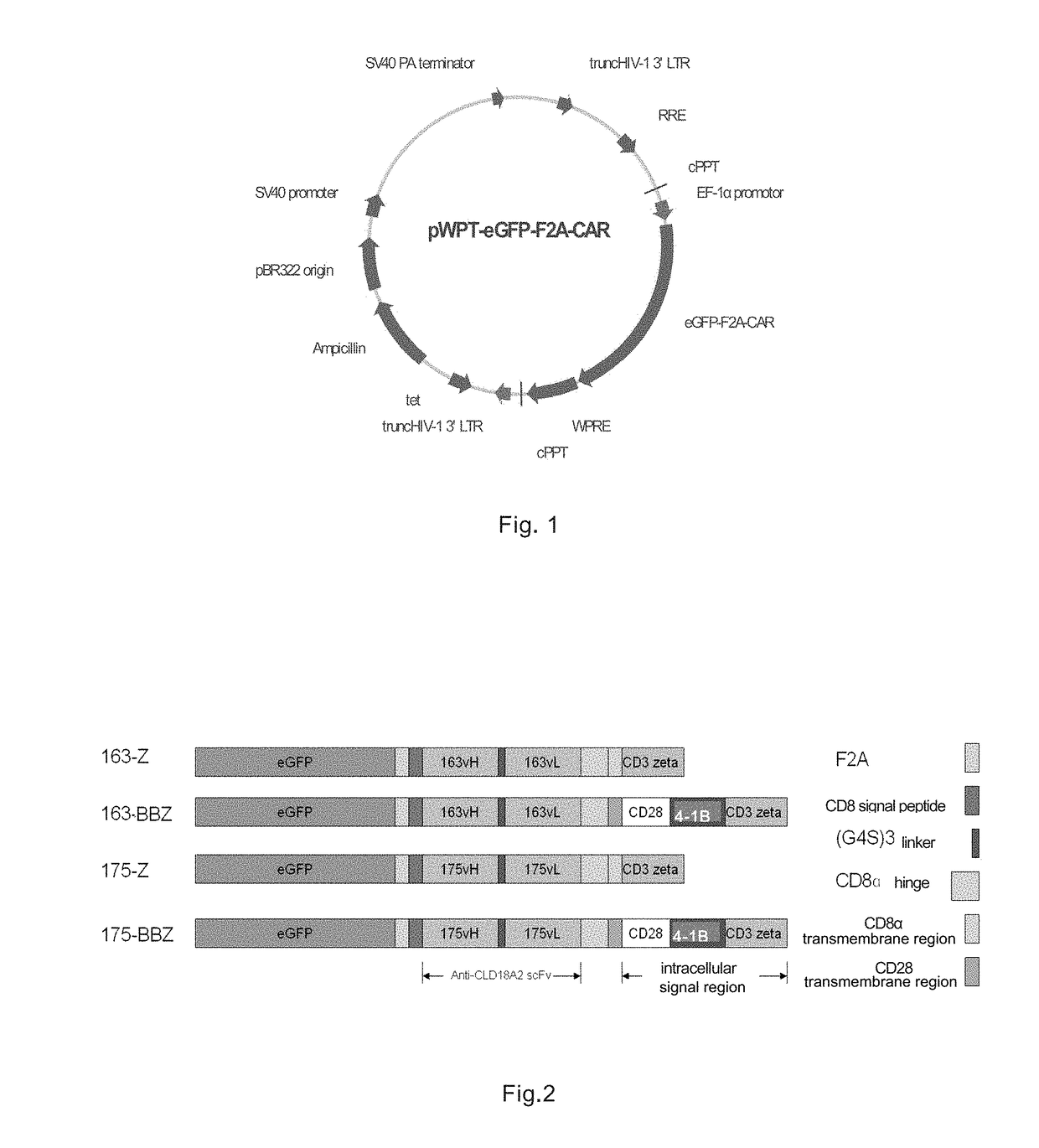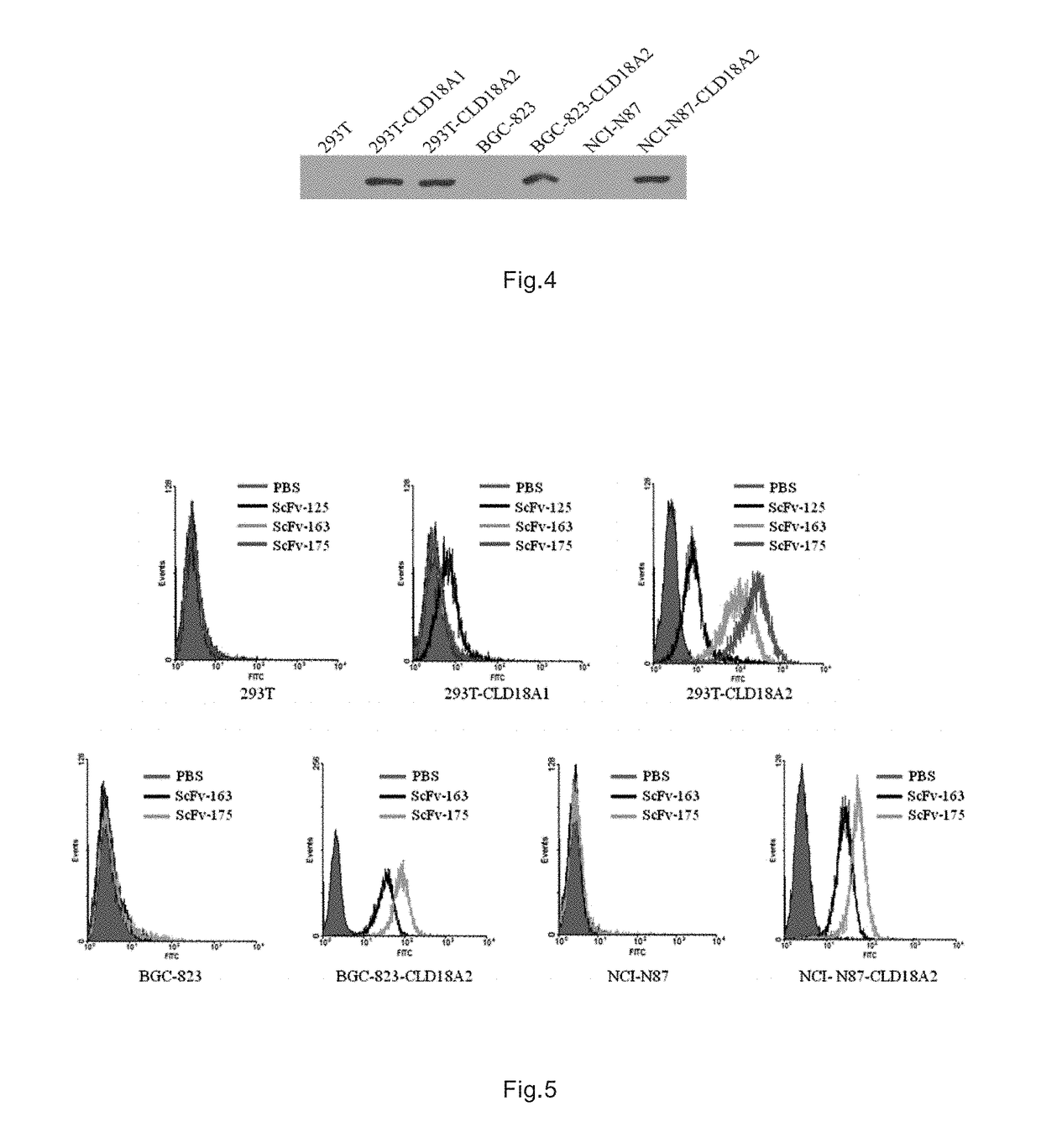Immunologic effector cell of targeted cld18a2, and preparation method and use thereof
a technology of immunomodulatory effector cells and target cells, which is applied in the field of cell therapy for tumors, can solve the problems of non-specific tissue damage, car t lymphocyte damage to normal tissues, and insufficient therapeutic effect in most tumors
- Summary
- Abstract
- Description
- Claims
- Application Information
AI Technical Summary
Benefits of technology
Problems solved by technology
Method used
Image
Examples
example 1
ssion of Single-Chain Antibody Against CLD18A2
[0067]By repeatedly researching and analyzing, the inventors indentified several scFv antibodies recognizing CLD18A2, for short, referred as 125,163, and 175.
[0068]125 (SEQ ID NO: 1 (nucleotide), 2 (amino acid)), 163 (SEQ ID NO: 3 (nucleotide), 4 (amino acid)), 175 (SEQ ID NO: 5 (nucleotide), and 6 (amino acid)) single-chain antibody sequences were synthesized by genetic synthesis based on bridging PCR. The synthesized products were digested by Nhe1 / BamH1 (purchased from NEB), ligated in plasmid vector pCMV-V5-Fc (the said plasmid fuses and expresses human antibody Fc at the downstream of the multi-cloning site, hereinafter referred to as V5-Fc for short, purchased from Shanghai raygene biotechnology Co., LTD) digested by the same Nhe1 / BamH1 via T4 DNA and was transformed into the host bacterium TOP10. The clones were picked and positive clones were identified by PCR, and confirmed by sequencing. V5-scFv-125-Fc, V5-scFv-163-Fc, and V5-sc...
example 2
ion of the Stable Expression Cell Line of CLD18A1 or CLD18A2
[0070]1. Construction of Expression Vectors of CLD18A1 and CLD18A2 and Preparation of Lentivirus
[0071]The complete coding sequences of CLD18A1 (GenBank: NM_016369) and CLD18A1 complete coding sequence (Genbank: nm_001002026) were synthesized by genetic synthesis technology based on bridging PCR. A flag tag(DYKDDDK) was inserted into the c-terminal, and MluI / SalI (purchased from NEB) were added at both ends of the synthesized gene segments. The segments were double-digested by MluI / SalI, ligated in plasmid vector pWPT (purchased from addgene) double-digested by the same MluI / SalI via T4 DNA, and were transformed into the host bacterium TOP10. The clones were picked and identified by PCR, and confirmed by sequencing. That correct lentivirus vector plasmid PWPT-CLD18A1, PWPT-CLD18A2 were obtained. The above plasmids and packing accessory plasmids (pGag-pol, pREV, pVsv-g (all purchased from addgene)) were co-transfected at a ce...
example 3
ion of Lentiviral Plasmids Expressing Chimeric Antigen Receptor Proteins Encoded by the Nucleic Acids of the Present Invention, and Virus Packaging
[0088]Table 1 explains the connection sequence of the exemplary chimeric antigen receptors of the present invention, the connection may also be seen in FIG. 2.
TABLE 1Extracellular binding region-transmembrane region-intracellularChimeric antigensignal region 1-intracellularreceptorsignal region 2, etcCLD18A2-δZscFv(CLD18A2)-CD8-CD3δzeta(negative control)CLD18A2-163-ZscFv(CLD18A2-163)-CD8-CD3 zetaCLD18A2-175-ZscFv(CLD18A2-175)-CD8-CD3 zetaCLD18A2-163-28BBZscFv(CLD18A2-163)-CD28a-CD28b-CD137(i.e. 4-1BB)-CD3 zetaCLD18A2-175-28BBZscFv(CLD18A2-163)-CD28a-CD28b-CD137-CD3 zeta
[0089]1. Amplification of Nucleic Acid Fragments
[0090](1) Amplification of scFv (CLD18A2-163, CLD18A2-175) Sequences
[0091]Using v5-scFv-163-fc plasmid as template, in the primer pair, the forward primer (SEQ ID NO: 7) comprises part of 2A sequence and the reverse primer (SE...
PUM
| Property | Measurement | Unit |
|---|---|---|
| concentration | aaaaa | aaaaa |
| volume | aaaaa | aaaaa |
| concentration | aaaaa | aaaaa |
Abstract
Description
Claims
Application Information
 Login to View More
Login to View More - R&D
- Intellectual Property
- Life Sciences
- Materials
- Tech Scout
- Unparalleled Data Quality
- Higher Quality Content
- 60% Fewer Hallucinations
Browse by: Latest US Patents, China's latest patents, Technical Efficacy Thesaurus, Application Domain, Technology Topic, Popular Technical Reports.
© 2025 PatSnap. All rights reserved.Legal|Privacy policy|Modern Slavery Act Transparency Statement|Sitemap|About US| Contact US: help@patsnap.com



